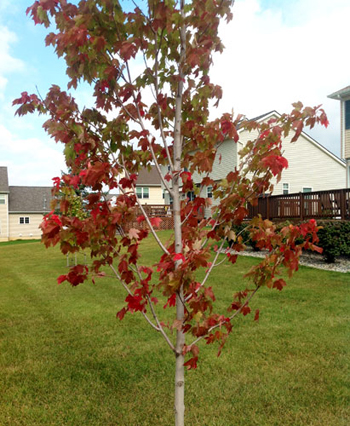Early fall color in trees and shrubs may be a sign of stress
Leaves that change color before fall are likely indicating stress.
 A red maple sample was brought into a Michigan State University Extension office in southern Michigan. The leaves were smaller than normal and had a beautiful shade of red along the edges. The red color is what we expect to see in autumn across Michigan, but this tree started to turn colors back in early August. Though beautiful in October, early fall color in landscape plants can be an indicator of a stressed plant. Your plants could be letting you know they are having problems and may need help.
A red maple sample was brought into a Michigan State University Extension office in southern Michigan. The leaves were smaller than normal and had a beautiful shade of red along the edges. The red color is what we expect to see in autumn across Michigan, but this tree started to turn colors back in early August. Though beautiful in October, early fall color in landscape plants can be an indicator of a stressed plant. Your plants could be letting you know they are having problems and may need help.
Burning bushes can turn color and drop leaves early when infested with spider mites. This commonly occurs when plants are growing in a location near a wall, sidewalk or driveway where reflected heat can cause stress. Heat-stressed burning bushes and other plants like Alberta spruces are prime locations for the buildup of mite populations that develop quickly under hot conditions causing injured foliage that turns color and drops early.
Damage to the base of a trunk or stem from animal feeding, weed whips, mowers and disease will reduce the flow of water and nutrients up a tree, leaving the plant weak and susceptible to other problems. This type of damage stresses the tree much like drought stress. Trees and shrubs weakened from these injuries may turn color early. Plants with damaged stems may need watering during dry conditions to prevent further damage.
The red maple brought into the MSU Extension office was not injured by a pest, disease or by mechanical equipment. It was injured during the drought of summer 2012 which showed greatly reduced growth the following spring. Drought-injured plants may not fully recover for a few years and, if weak to begin with, they may not recover. Often this type of stress is evident in reduced growth of the branches, small leaves and early fall color.
Pay attention to changes in plants, such as leaves turning color during the last couple months of the summer. These types of indicators are a red flag that needs attention. Not all injuries can be corrected, but the impact of the stress can often be reduced by watering heat or drought-stressed plants. It can be minimized through the proper use of mulches to help reduce the loss of water from the soil and also to protect roots from quick changes in soil temperatures. Careful inspection of the plant may show insect damage that if caught early may prevent needless injuries.
If you have questions about plants turning colors early, contact the MSU Extension State Garden Hotline at 888-678-3464 or visit the Gardening in Michigan website and use the Ask an Expert box to submit a question.
Though plants do not all live to be 100 or more years, we can maximize their life by paying attention to nature’s clues.



 Print
Print Email
Email




